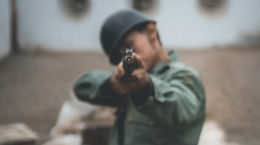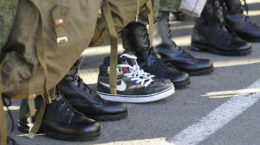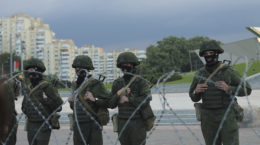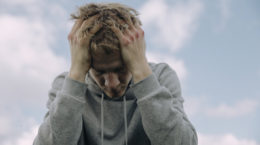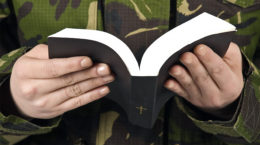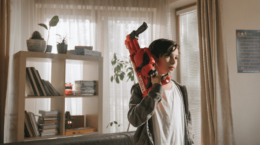Militarization of boys in Belarus starts long before their conscription to the military service. School, higher educational institutions as well as various “military patriotic” clubs take active participation in it.
Soon, in all Belarusian higher educational establishments, students will be made to learn basic military training. It was said on May 31, 2023, by the Defense Minister of the Republic of Belarus, Viktor Khrenin. According to him, basic military training is planned to be taught in all higher educational institutions of Belarus. A correspondent joint document with the Ministry of Education has already been adopted, and academic hours for studying the special course have been assigned.
Well, at least university students are mostly grown-up people. Yet, the Ministry of Defence starts taking interest in its future “cannon fodder” much earlier. From the age of 14, Belarusian teenagers get summoned to military registration and enlistment offices, for “data verification”. From the same age, boys have difficulties with travelling abroad: there is no direct ban on it, but it is not easy to get a special passport for foreign travel.
A lot of cases have already been registered, when a 14–17-year-old teenage citizen of the Republic of Belarus, who is constantly resident abroad, comes to Belarus for some reason and is not let out of the country “until he pays off his debt to the motherland” by serving in the army or is declared free from such service on medical grounds.
Schoolchildren are also being prepared for the war at the schools of Belarus. Preliminary military training, or initial military training, as this subject was called before, is obligatory for high school students. Not only for boys: girls pass a special course in medical training. Since September 1, 2021, the position of a head for military patriotic training returned to schools, the famous “voenruk” (military instructor of the times of the USSR). As of March, 2023, Belarusian schools were staffed with military instructors by 93%.
Their “work” involves organizing and conducting thematic lessons, taking care of the veterans, improving military graves and burial sites, studying history of military units, formations, acting partisan detachments and underground movement groups during the Great Patriotic War in the territories where their schools are situated, organizing trips to places of military glory…
A subject copying the Soviet times one, called “Basic military training”, or “Preliminary military training”, included into the curriculum of the secondary general education of the modern Belarus, is a 130-academic-hour-long course for the 10th grade students and 70-hour-long course for the 11th grade ones. The compulsory part is a field training for boys at the premises of a military unit, and practical classes for girls. It’s not possible to ignore that: the truant may not be transferred to the graduating year.
In 2022, statutory ratios have been added to the curriculum. Such as incomplete disassembling of a machine gun and its assembling, equipping magazines with training bullets, putting on gas helmets, respirators and all-service protective gear, acting upon hearing a gas alarm signal, elements of marching drill and tactical training, military topography. In the field of military medical training, such statutory ratios include roll-out of personal field/battle dressing, wound dressing, hemostatic rubber tourniquet application, use of unit-dose syringe, etc.
The technical and material base for that had been created gradually. The main focus was made on founding centers for pre-conscription training. Every such structure unites pupils of several schools. Block-modular approach is used to organize the educational process, when all the material provided for a year is being studied in the course of several days. Besides that, high school students get an “opportunity” to attend elective courses, sport and technical classes and other classes of applied nature. Such centers are headed by reserve officers. Classes are held by officers of district military registration and enlistment offices, pedagogues and cadets of military faculties, students of the medical university. Equipment of the centers: air rifle shooting gallery, Kalashnikov training submachine guns, visual aids, and so on.
During the “pre-conscription training” classes, groups of students are called “platoons” (a platoon is divided into two-three branches). Some high school students are appointed commanders of a platoon or of a platoon branch. Every lesson starts with a lineup, verification of the presence of students and reporting to the teacher about readiness for the training lesson. Requirements of military regulations must be observed during the lesson when students perform actions, answer questions or address the teacher.
It should be taken into consideration, that such pre-conscription and medical training of high schoolers is not the only component of a complex of measures taken to militarize Belarusian teenagers. One of other components involves military patriotic camps organized for children and teenagers during summer vacations. The curriculum there is similar to the military preparation at schools, but is more advanced and ideologically saturated. At the same time, children’s life in such camps reminds most of all the life of soldiers, with military uniform, barracks and a corresponding daily routine.
Besides that, detachments of uniformed agencies eagerly take patronage over educational institutions. In the Belarusian schools there are also military patriotic specialized grades. In the scholastic year 2021/2022 they included almost fifteen hundred high schoolers of the 10th and 11th grades. They study two subjects at the advanced level: physics or mathematics and a foreign language, and they master the curriculum of elective courses “We are ready to serve the Motherland!” or “A young border guard”, elaborated by the Ministry of Education in collaboration with the Ministry of Defense and the State Border Committee. Criteria for the enrollment into such specialized grade include good physical characteristics, good health condition and a grade point average of the certificate of basic secondary education’s not lower than 7 (according to the 10-point grading system used in Belarus).
Our House





